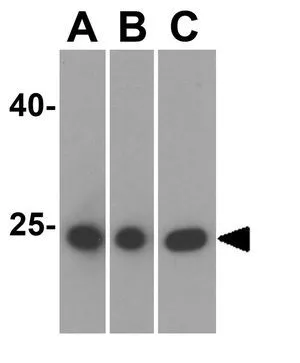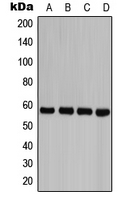![WB analysis of HEK293 cell lysate using GTX30244 Caspase 8 antibody [FLICE 4-1-20]. Lanes 1 : inactive Caspase 8 Lane 2 : active Caspase 8 Dilution : 1:500 WB analysis of HEK293 cell lysate using GTX30244 Caspase 8 antibody [FLICE 4-1-20]. Lanes 1 : inactive Caspase 8 Lane 2 : active Caspase 8 Dilution : 1:500](https://www.genetex.com/upload/website/prouct_img/normal/GTX30244/GTX30244_1376_WB_w_23060722_596.webp)
WB analysis of HEK293 cell lysate using GTX30244 Caspase 8 antibody [FLICE 4-1-20]. Lanes 1 : inactive Caspase 8 Lane 2 : active Caspase 8 Dilution : 1:500
Caspase 8 antibody [FLICE 4-1-20]
GTX30244
ApplicationsWestern Blot
Product group Antibodies
TargetCASP8
Overview
- SupplierGeneTex
- Product NameCaspase 8 antibody [FLICE 4-1-20]
- Delivery Days Customer9
- Application Supplier NoteWB: 1:1000. *Optimal dilutions/concentrations should be determined by the researcher.Not tested in other applications.
- ApplicationsWestern Blot
- CertificationResearch Use Only
- ClonalityMonoclonal
- Clone IDFLICE 4-1-20
- ConjugateUnconjugated
- Gene ID841
- Target nameCASP8
- Target descriptioncaspase 8
- Target synonymsALPS2B, CAP4, Casp-8, FLICE, MACH, MCH5, caspase-8, FADD-homologous ICE/CED-3-like protease, FADD-like ICE, ICE-like apoptotic protease 5, MACH-alpha-1/2/3 protein, MACH-beta-1/2/3/4 protein, MORT1-associated ced-3 homolog, apoptotic cysteine protease, apoptotic protease Mch-5, caspase 8, apoptosis-related cysteine peptidase, caspase 8, apoptosis-related cysteine protease
- HostMouse
- IsotypeIgG1
- Protein IDQ14790
- Protein NameCaspase-8
- Scientific DescriptionThis gene encodes a member of the cysteine-aspartic acid protease (caspase) family. Sequential activation of caspases plays a central role in the execution-phase of cell apoptosis. Caspases exist as inactive proenzymes composed of a prodomain, a large protease subunit, and a small protease subunit. Activation of caspases requires proteolytic processing at conserved internal aspartic residues to generate a heterodimeric enzyme consisting of the large and small subunits. This protein is involved in the programmed cell death induced by Fas and various apoptotic stimuli. The N-terminal FADD-like death effector domain of this protein suggests that it may interact with Fas-interacting protein FADD. This protein was detected in the insoluble fraction of the affected brain region from Huntington disease patients but not in those from normal controls, which implicated the role in neurodegenerative diseases. Many alternatively spliced transcript variants encoding different isoforms have been described, although not all variants have had their full-length sequences determined. [provided by RefSeq]
- Storage Instruction2°C to 8°C
- UNSPSC12352203






![ELISA analysis of antigen using GTX60510 Caspase 8 antibody [1H11]. Red : Control antigen 100ng Purple : Antigen 10ng Green : Antigen 50ng Blue : Antigen 100ng](https://www.genetex.com/upload/website/prouct_img/normal/GTX60510/GTX60510_20170912_ELISA_w_23061123_161.webp)
![ICC/IF analysis of HeLa cells using Caspase 8 antibody [EPR162] at a dilution of 1:100.](https://www.genetex.com/upload/website/prouct_img/normal/GTX63075/GTX63075_ICCIF_1_w_23061202_434.webp)